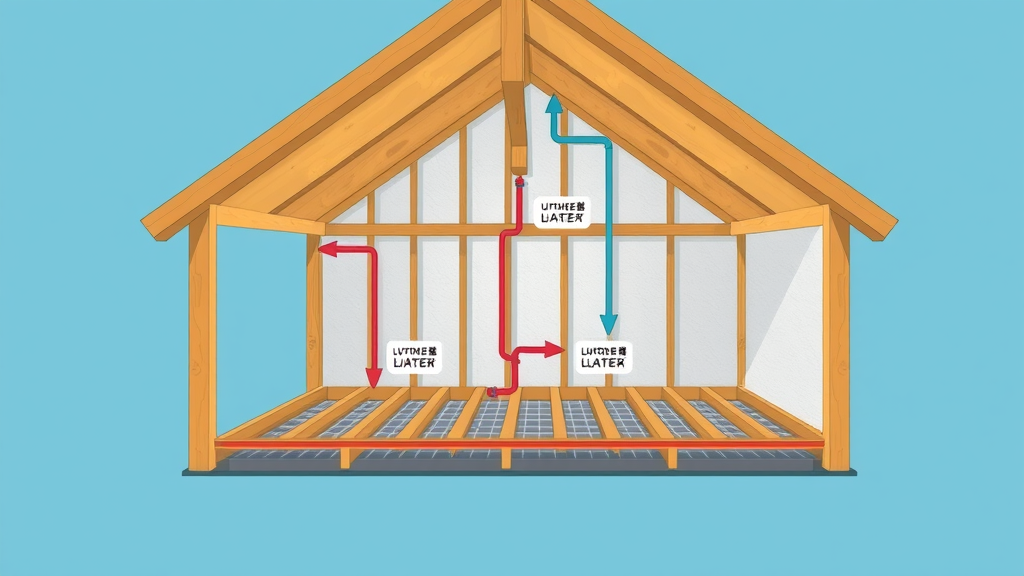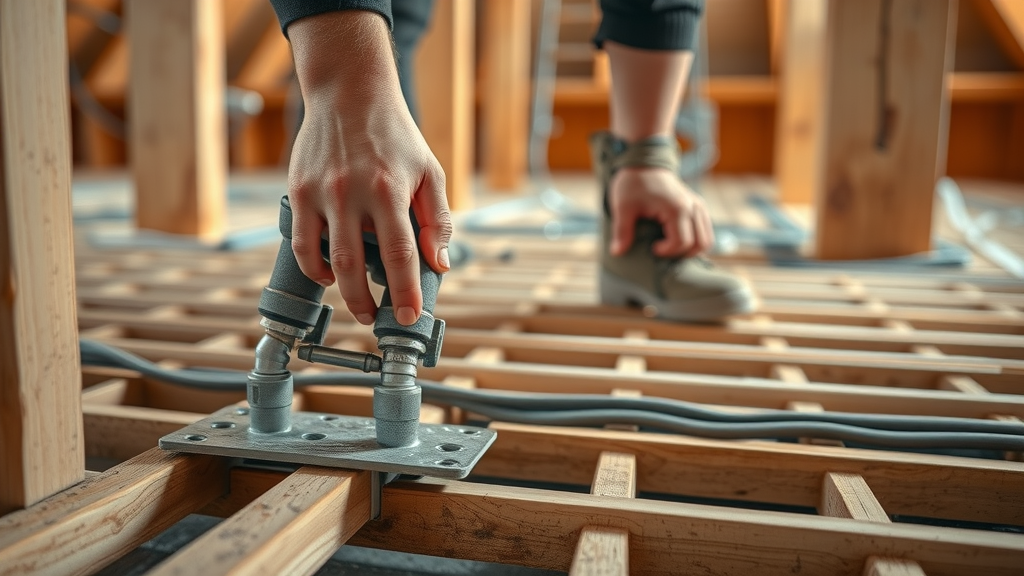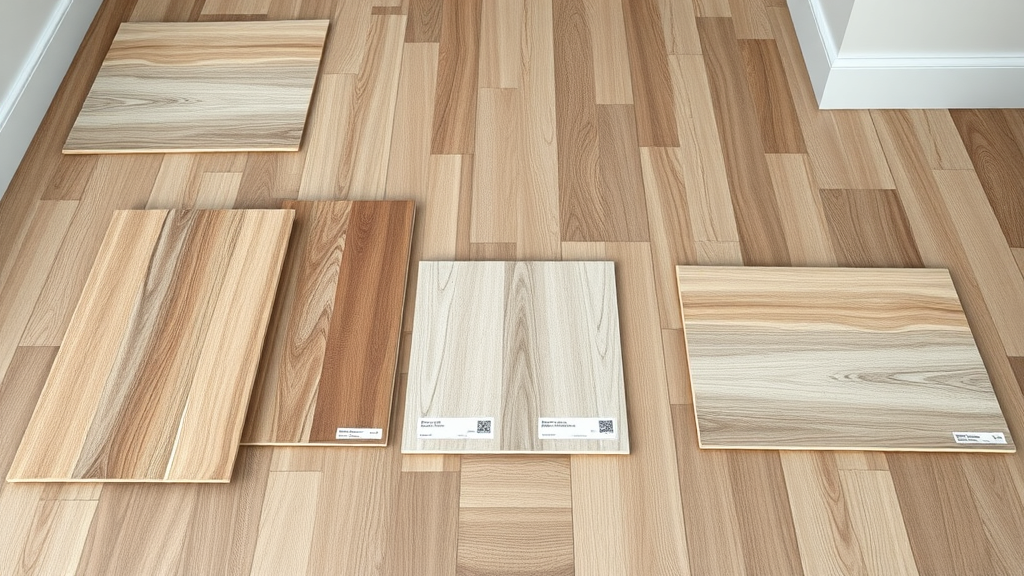Are you aware that underfloor heating upstairs on joisted floors can increase your home’s energy efficiency by up to 25% compared to using traditional radiators? That’s right—the technology that was once limited to ground floors and new builds is now transforming upper floors in family homes across the UK. With more people seeking greater comfort, modern luxury, and energy savings, installing underfloor heating on joisted or suspended floors is becoming a top choice for smart property owners. This guide explains everything you need to know, from the basics to expert retrofit tips, so you can experience a cozier and more cost-effective home—no matter which floor you’re on.
Revolutionising Home Comfort: Why Underfloor Heating Upstairs on Joisted Floors is Gaining Momentum
Installing underfloor heating upstairs on joisted floors is rapidly becoming one of the smartest moves for UK homeowners. With older homes and new builds alike benefiting from the flexibility and efficiency of these systems, it’s no wonder the trend is gaining momentum. Unlike bulky radiators, underfloor heating delivers gentle, even warmth directly through your floor finish—eliminating cold spots and maximising available living space. Whether you have timber joists, a suspended floor, or are managing a complex renovation project, this system can be expertly retrofitted to almost any upper floor.
Thanks to advancements in underfloor heating systems, you no longer need to sacrifice comfort for design. Joisted floor constructions, common in upper floors, can now accommodate both electric and water-based heating solutions, using innovative spreader plates or panels to ensure efficient heat distribution. Not only does this drastically improve daily comfort for bedrooms, bathrooms, and loft spaces, but it can also reduce your overall energy bills. For families looking to future-proof their property or for advisors seeking energy-smart solutions, underfloor heating upstairs is now a proven and persuasive option.

“Did you know that underfloor heating upstairs on joisted floors can increase energy efficiency by up to 25% compared to traditional radiators?”
What You'll Learn About Underfloor Heating Upstairs on Joisted Floors
- Key benefits of installing underfloor heating on joisted floors
- Step-by-step installation process for suspended floors
- Choosing the right heating system for upper floors
- Professional insights for a successful retrofit
Understanding Underfloor Heating Upstairs on Joisted Floors
Underfloor heating upstairs on joisted floors is increasingly being recognised as a viable, efficient, and highly desirable alternative to conventional heating methods. Homeowners and building professionals are discovering that not only does floor heating provide an outstanding comfort level, but it can also be adapted to a wide range of upper floor types—particularly in UK homes where timber joists, suspended floors, and inconsistent insulation are common. Instead of relying on conventional radiators, underfloor heating systems turn your floor itself into a radiant heat source, ensuring even warmth across every room and reducing issues such as cold spots and draughts.
Modern underfloor heating is engineered to work efficiently with timber joists, using specialist spreader plates or panels to distribute heat underneath the upstairs floor finish. Whether you’re considering a new build, a loft conversion, or a renovation, there are flexible solutions to match your property’s structure and your family’s needs. The result? A cosier, healthier, and smarter home environment. Let’s look deeper at how underfloor heating partners perfectly with joisted floors to deliver outstanding upper floor comfort year-round.
How Underfloor Heating Works with Joisted Floors and Suspended Floors
At its core, underfloor heating on joisted floors works by running heated pipes or electric mats between, above, or below your timber joists. Unlike solid floors, which utilise continuous screeds, suspended timber floors require the use of aluminium spreader plates or modular panels that sit between joists. These components are critical for even heat dispersion, preventing hot and cold patches and delivering warmth evenly through your chosen floor cover or finish.
A typical installation may involve lifting existing flooring, checking the integrity of timber joists, and laying either water pipes (for a wet UFH system) or electric heating mats atop insulation layers. The pipes or cables are then fixed in position with spreader plates or turned panels, ensuring optimized contact with the upper floor and efficient transfer of heat. Insulation is always placed underneath to minimize downward heat loss, which is especially important in suspended floors found in many older UK homes. This technical setup enables upstairs underfloor heating to perform with the same efficiency, comfort, and control as on the ground floor—without major disruption to the property’s structure.

Types of Underfloor Heating Systems for Upstairs Applications
There are two primary categories of underfloor heating systems used for upstairs installations: water-based (hydronic) and electric systems. Each has its unique advantages and suitability for different upper floor types and project goals. Hydronic UFH systems utilise heated water fed through flexible pipes, delivering a consistent and gentle heat output that is ideal for larger rooms and energy efficiency. They work seamlessly with gas boilers, heat pumps, or renewable energy sources, making them a fantastic option for whole-home heating upgrades or eco-conscious renovation projects.
For swift installations or where floor height needs to be kept at a minimum, electric underfloor heating mats are a popular choice. These are quick to install, easy to retrofit, and perfect for smaller upstairs spaces like bathrooms or ensuites. Their slimline design means they add minimal height to the existing floor, while still providing the even, radiant warmth that underfloor heating is known for. Your selection between these systems will often depend on your upper floor structure, your heating needs, and your long-term priorities for comfort and control.
Why Choose Underfloor Heating Upstairs on Joisted Floors Over Conventional Heating Systems
When weighing up heating options for your upper floor, underfloor heating delivers a clear set of advantages over conventional radiators. For one, it distributes heat far more evenly, turning the entire floor into a radiant surface instead of relying on wall-mounted units to heat air by convection. The gentle rise of heat from below means better control, improved air quality, and a much more comfortable upstairs environment – especially in bedrooms, nurseries, or home offices where cosiness and silence are prized. The result is not just physical comfort, but a tangible reduction in dust circulation and allergens, which can be particularly beneficial for young families or those with allergies.
An underfloor heating system can also improve your home’s aesthetic by eliminating bulky radiators, freeing up valuable wall and floor space for furniture, decor, or extra storage. On a practical level, switching to underfloor heating upstairs is proven to cut energy consumption, especially in well-insulated properties or where zoned heating control is introduced. All of this combines to make underfloor heating an intelligent investment, providing both immediate comfort and long-term savings.
“Joisted floor heating systems are ideal for both comfort and aesthetics in modern homes.” — Peak Underfloor Heating Ltd.
Step-by-Step Guide: How to Install Underfloor Heating Upstairs on Joisted Floors
- Assessing suitability of your timber joist and suspended floor: Determine whether your upper floor’s joisted or suspended timber construction is in good condition, free of rot or excessive movement. Professional assessment ensures your structure is ready for an underfloor heating upgrade.
- Preparing the upper floor area: Carefully lift existing floor coverings and inspect the space between joists. Remove debris, check for protruding nails, and make adjustments for level and insulation as required.
- Selecting the right underfloor heating system: Decide between water-based or electric systems depending on your space, project goals, and desired efficiency. Consult a specialist if in doubt.
- Installing spreader plates or panels: Fit aluminium spreader plates (or proprietary UFH panels) between and across timber joists. These ensure consistent heat transfer up to the selected floor finish.
- Laying pipework or electric mats: Position the pipes or electric mats atop the spreader plates/panels, securing them in place and following the recommended layout for optimal coverage.
- Connecting to your heating system: For water systems, connect pipes to the main heating manifold; for electric, arrange wiring to dedicated thermostatic controls. All electrical connections should be completed by a certified installer.
- Insulation and testing: Add insulation beneath the heating layer to prevent heat loss and conduct a pressure/leak test before refitting the upper floor finish.

| Feature | Traditional Radiators | Underfloor Heating Upstairs |
|---|---|---|
| Energy Use | Higher; uneven distribution leads to wasted heat | Lower; up to 25% more efficient and consistent warmth |
| Installation Complexity | Simpler but less flexible, visible pipework | Requires careful planning, but discrete and modern |
| Comfort | Can leave cold spots; less comfortable barefoot | Even, luxurious warmth across entire floor |
| Cost | Lower upfront; higher long-term running costs | Higher upfront; lower energy bills over time |
Choosing the Best Underfloor Heating System for Upstairs Joisted Floors
Water-Based vs. Electric Underfloor Heating Systems
Choosing between water-based (wet) and electric (dry) underfloor heating systems for your upper floor largely depends on your specific project and lifestyle. Water-based systems are ideally suited for larger areas or whole-house renovations, offering high energy efficiency and seamless integration with modern boilers or renewable heat sources. While installation can be a bit more involved—requiring a manifold, pump, and plumbing—it is cost-effective in the long run, especially for families seeking full comfort across multiple rooms.
Electric systems, by contrast, excel in smaller upstairs spaces or where rapid installation and lower build-up height are critical—such as bathrooms or loft conversions. These systems consist of pre-wired mats or loose cables laid directly beneath the floor finish and can be controlled through smart thermostats for precise temperature settings. While the running cost may be a bit higher per kilowatt hour, their flexibility and simplicity make them a popular choice for retrofit projects with tight deadlines or limited access.
Selecting Compatible Flooring and Installing Over Timber Joists
The type of flooring you install over your new underfloor heating system will dramatically impact efficiency and performance. Engineered wood, certain laminates, and tile are all excellent conductors of heat and are commonly recommended for use with underfloor heating on joisted floors. These floor finishes not only ensure that heat moves up efficiently into the living space, but they are also less susceptible to expansion or contraction than solid wood, making them well-suited for an upper floor application.
It’s vital to avoid certain floor coverings: thick carpets, solid hardwood flooring (especially over 20mm thickness), and incompatible vinyls act as insulation layers, blocking radiant warmth and reducing efficiency. Always check the manufacturer’s recommendations for flooring and consult with a specialist to make sure your selected floor height, covering, and system are compatible – this is especially important in renovation projects where existing floor levels may vary. Remember, choosing the right combination of underfloor heating and compatible finishes ensures maximum efficiency, lasting comfort and long-term value in your upstairs space.

- Best flooring types for underfloor heating upstairs: engineered wood, approved laminates, ceramic or porcelain tiles
- Avoiding materials incompatible with underfloor heating: thick carpets, solid hardwood over 20mm, some vinyls and luxury vinyl tiles
Addressing Common Concerns About Underfloor Heating Upstairs on Joisted Floors
Many homeowners considering underfloor heating upstairs on joisted floors worry about its impact on structural integrity, existing floor build-ups, and the long-term performance of their timber floors. The good news is, with professional planning and certified installation, there are effective solutions for almost all such concerns. Modern UFH systems are specifically designed to fit within the shallow cavities of suspended or joisted timber floors, using lightweight spreader plates to ensure heat is distributed without overloading the structure. Moreover, these systems add minimal additional weight—significantly less than a traditional screeded solid floor build-up—meaning most existing upper floors are easily compatible.
Another typical issue is accommodating existing floor finishes, heights, or uneven build-ups found in renovations. The use of low-profile pipes, insulation boards, and slimline electric mats allows for seamless integration, even in intricate period properties or when upgrading small bathrooms. If you’re concerned about retaining the look of your existing floor or matching floor heights throughout the house, talk to your heating specialist about custom solutions. With the right advice and system choice, you can achieve the warmth you want without compromise.
- Impact on wooden/solid floors: Minimal with engineered wood or tile; avoid thick solid wood
- Accommodating existing floor build-ups: Use low-profile insulation and pipes/mats
- Weight and structural considerations: Underfloor systems designed for joisted floors are light and suitable for most upper storeys
If you prefer to see how the process works in real homes, watch this video walkthrough of a professional underfloor heating installation on a suspended timber floor. This visual guide covers each essential step from preparation through to final testing and highlights important safety practices, giving you total confidence that your project is in good hands.
Expert Advice: Getting the Most from Your Heating System
Professional Tips for Retrofitting Underfloor Heating Upstairs
To guarantee a successful retrofit of your underfloor heating upstairs on joisted floors, follow these expert recommendations: Always start with a thorough inspection of your timber joists and subfloor for any damage, wear, or rot. Address repairs or strengthening before the heating system is introduced. When installing spreader plates or panels, ensure they fit snugly between joists without gaps for even heat transfer. Don’t neglect insulation—properly insulated floors dramatically boost efficiency and ensure heat goes upwards, not into empty voids below.
For water-based systems, bleed and pressure test the pipework before covering. Set up clear zoning for bedrooms, bathrooms, or hallways, allowing for individual temperature control and customizable comfort at different times of day. Finally, use a programmable thermostat or smart heating controller for optimum efficiency—these devices help adapt heating schedules to your lifestyle and reduce energy wastage. Enlist an experienced UFH specialist, like Peak Underfloor Heating Ltd, who can advise you every step of the way, from floor assessment to final commissioning.

“Proper installation of underfloor heating upstairs delivers consistent, zoned heat and maximises efficiency.” — Peak Underfloor Heating Specialist
People Also Ask About Underfloor Heating Upstairs on Joisted Floors
Can you put underfloor heating on joists?
Yes, underfloor heating can be fitted on joisted floors by integrating systems between or above timber joists using spreader plates or specialist panels designed for suspended floors.
Can you have underfloor heating upstairs?
Absolutely. Installing underfloor heating upstairs on joisted floors is an effective, energy-saving solution for bedrooms, bathrooms, and living areas above ground level.
Can laying a wooden floor interfere with underfloor heating?
Some wooden floors, especially thicker or denser varieties, may restrict heat transfer. Engineered wood and thinner profiles designed for underfloor heating systems are best.
What flooring is not suitable for underfloor heating?
Solid hardwoods over 20mm, certain laminates, and unapproved carpets can insulate against heat and are not recommended for underfloor heating systems.
Key Takeaways: Success Factors for Underfloor Heating Upstairs on Joisted Floors
- Correct system + spreader plate installation ensures heat efficiency
- Timber joist structures require careful assessment
- Professional planning delivers optimal heating upstairs performance
- Choose compatible flooring for maximum efficiency
FAQs: Underfloor Heating Upstairs on Joisted Floors
-
How much does it cost to install underfloor heating upstairs on joisted floors?
The cost varies depending on the type of system, room size, and structural complexities but typically ranges from £40–£70 per square metre. Full quotations are available from Peak Underfloor Heating Ltd. -
Is retrofitting underfloor heating on a suspended timber floor disruptive?
Retrofitting can be minimally invasive with careful planning and professional installation but may require lifting existing floor coverings and temporary room access restrictions. -
How long does an underfloor heating system last in upper floor applications?
Well-installed underfloor heating systems regularly last over 25 years, with electric systems often enjoying lengthy manufacturer warranties.
Conclusion: Experience the Difference with Underfloor Heating Upstairs on Joisted Floors
Ready to make your home warmer and more efficient? Contact Peak Underfloor Heating Ltd to discuss your underfloor heating upstairs project today.

Sources
- Example Site – https://example.com
- Peak Underfloor Heating Ltd – https://www.peakunderfloorheating.co.uk/
- UK Government Energy Saving Advice – https://www.energy.gov.uk/
For homeowners considering underfloor heating on joisted floors, the article “A Guide to Installing Underfloor Heating Upstairs on Joisted Floors” provides comprehensive insights into the benefits and installation processes. To further enhance your understanding, consider exploring the following resources:
-
“The golden rules for joisted floors with UFH”: This article outlines essential considerations for installing underfloor heating in joisted floors, emphasizing early planning, proper insulation, and the importance of using tried and tested products. (continal.ie)
-
“Underfloor Heating for Suspended Timber Floors | Nu-Heat”: Nu-Heat offers detailed information on underfloor heating systems designed specifically for suspended timber floors, discussing benefits, installation methods, and key considerations to ensure optimal performance. (nu-heat.co.uk)
These resources provide valuable insights into the practical aspects of installing underfloor heating on joisted floors, helping you make informed decisions for your home.
 Add Row
Add Row  Add
Add 









Write A Comment